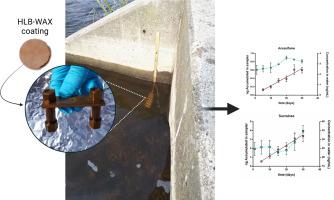Development and validation of a retracted thin film solid phase microextraction device for time weighted average monitoring of artificial sweeteners concentration in surface waters
IF 6.2
引用次数: 0
Abstract
A retracted thin-film solid phase microextraction device was used as a passive sampler to monitor the time-weighted average concentration of artificial sweeteners (AS) in Grand River, Ontario, Canada. Laboratory and field calibration were performed to determine differences in the estimated sampling rate values. Laboratory sampling rates ranged from 0.0033 mL day-1 for neohesperidin dihydrochalcone to 0.0075 mL day-1 for saccharin. Sampler devices were deployed for 30 days downstream of a municipal wastewater treatment plant in the Grand River, Ontario, Canada. Linear accumulation for four AS was observed (R2>0.9363) in the sampling devices over 30 days, and in-situ sampling rates were between 0.0045 ± 0.0002 for sucralose and 0.0070 ± 0.0009 mL day-1 for acesulfame. The estimated sampling rates for the river and laboratory exhibited <20 % deviation from the theoretical values. Simultaneously, water samples from the Grand River were collected to determine the concentration levels of artificial sweeteners. The concentration of acesulfame, saccharin, cyclamate, aspartame, and sucralose in the Grand River ranged from 0.13 to 26.5 ng mL-1. The validation results indicated that this device is suitable for long-term monitoring of AS in surface waters.

用于地表水人工甜味剂浓度时间加权平均监测的缩回式薄膜固相微萃取装置的研制与验证
采用缩回式薄膜固相微萃取装置作为被动采样器,对加拿大安大略省格兰德河地区人工甜味剂(as)的时间加权平均浓度进行了监测。进行了实验室和现场校准,以确定估计采样率值的差异。实验室取样率从新橙皮苷二氢查尔酮的0.0033 mL /天到糖精的0.0075 mL /天不等。采样器装置在加拿大安大略省格兰德河的一个市政污水处理厂下游部署了30天。在30 d内,4种AS在采样装置中呈线性累积(R2>0.9363),三氯蔗糖的原位采样率为0.0045±0.0002 mL,安赛蜜的原位采样率为0.0070±0.0009 mL d -1。河流和实验室的估计采样率与理论值有20%的偏差。同时,从格兰德河收集水样以确定人工甜味剂的浓度水平。格兰德河中乙酰磺胺、糖精、甜蜜素、阿斯巴甜和三氯蔗糖的浓度在0.13至26.5 ng mL-1之间。验证结果表明,该装置适用于地表水中砷的长期监测。
本文章由计算机程序翻译,如有差异,请以英文原文为准。
求助全文
约1分钟内获得全文
求助全文

 求助内容:
求助内容: 应助结果提醒方式:
应助结果提醒方式:


